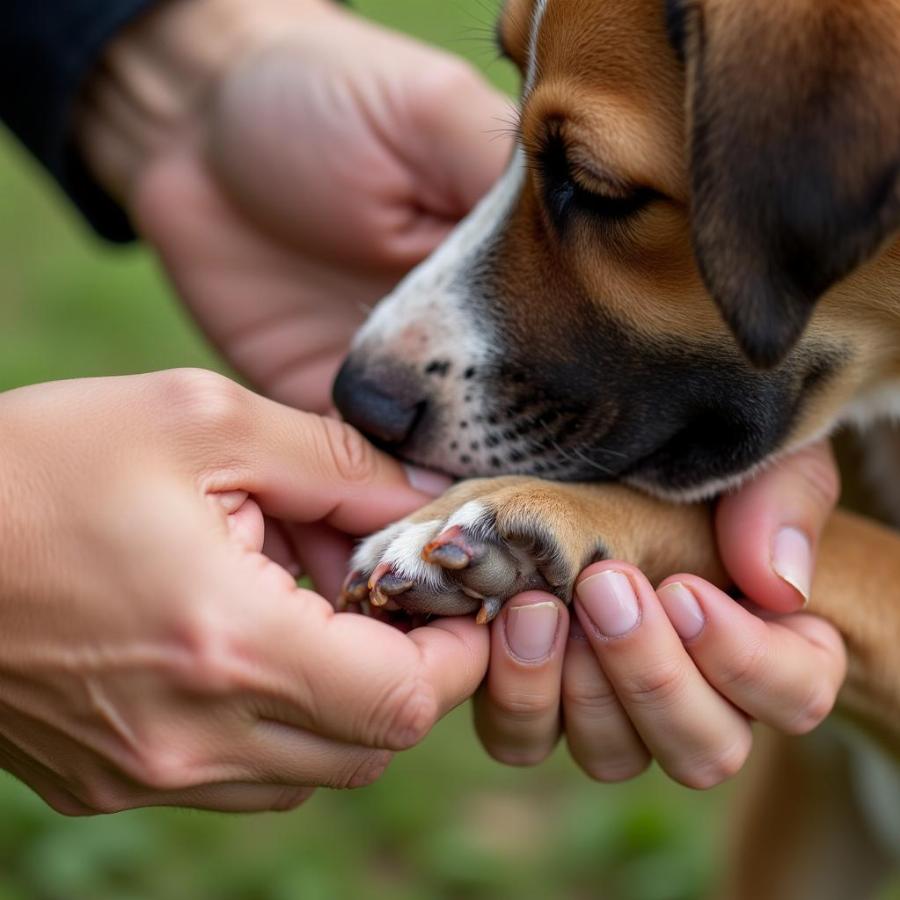Discovering a cut on your furry friend’s paw can be alarming. Dogs explore the world with their paws, making them susceptible to cuts, scrapes, and punctures. Knowing how to properly treat a cut on a dog’s paw is crucial for every dog owner. This guide will walk you through the steps to ensure your pup’s paw heals quickly and safely.
Assessing the Injury
Before treating the cut, it’s important to assess the severity. A minor cut may only require cleaning and monitoring, while a deeper cut may need veterinary attention.
Here’s what to look for:
- Bleeding: Is the bleeding continuous, or does it stop after a few minutes?
- Depth: Is the cut superficial, or can you see deeper tissues?
- Debris: Are there any foreign objects lodged in the cut, like glass or thorns?
- Limping: Is your dog limping or showing signs of pain?
If the bleeding is profuse, the cut is deep, or you see debris, it’s best to seek immediate veterinary care.
 Treating a Cut on a Dog's Paw
Treating a Cut on a Dog's Paw
Cleaning the Wound
For minor cuts, you can start treatment at home.
Follow these steps:
- Restrain Your Dog: Have a second person gently restrain your dog to prevent movement during the cleaning process.
- Control Bleeding: Apply gentle pressure to the cut using a clean gauze pad or cloth for a few minutes to stop any bleeding.
- Trim Hair: If the hair around the cut is long, carefully trim it away with blunt-tipped scissors to prevent it from sticking to the wound and hindering healing.
- Cleanse the Cut: Use lukewarm water and a mild antibacterial pet-safe soap to gently wash the paw and remove any dirt or debris. Avoid using hydrogen peroxide or rubbing alcohol, as they can damage tissues and delay healing.
- Dry the Area: After cleaning, pat the paw dry with a clean towel.
Applying Antibiotic Ointment
Once the wound is clean and dry, apply a thin layer of pet-safe antibiotic ointment to prevent infection. You can find these ointments at pet stores or your veterinarian’s office.
Bandaging the Paw
Whether or not to bandage the paw depends on the location and severity of the cut.
- Small, Superficial Cuts: These often don’t require a bandage and can be left open to air dry. However, keep a close eye to ensure your dog isn’t licking the wound.
- Larger or Deeper Cuts: These may benefit from a bandage to keep the area clean, prevent licking, and provide support.
How to apply a bandage:
- Use Non-Stick Pads: Place a sterile, non-stick gauze pad directly over the cut.
- Secure with Vet Wrap: Wrap the paw securely with self-adhesive bandage tape, commonly known as vet wrap. Ensure it’s snug but not too tight.
- Cover with a Protective Layer: To keep the bandage clean and dry, especially during walks, use a dog bootie or a securely fastened plastic bag.
Monitoring and Follow-Up Care
Even with proper care, it’s essential to monitor the cut closely for any signs of infection.
Watch for:
- Redness
- Swelling
- Discharge
- Foul odor
- Increased pain or limping
If you notice any of these signs, contact your veterinarian immediately.
Preventing Future Paw Injuries
While accidents happen, you can minimize the risk of future paw injuries by:
- Checking Paws Regularly: Make it a habit to check your dog’s paws after walks or playtime, especially in areas with potential hazards like broken glass or sharp rocks.
- Trimming Nails: Keep your dog’s nails trimmed to prevent them from catching and tearing.
- Using Protective Booties: Consider using dog booties for walks in harsh weather conditions or on rough terrain.
When to Seek Veterinary Attention
Knowing when to seek veterinary care is crucial for your dog’s health.
Contact your veterinarian immediately if:
- The bleeding doesn’t stop after applying pressure for several minutes.
- The cut is deep or gaping open.
- You see bone, tendons, or other deep tissues.
- You suspect an infection.
- Your dog is in significant pain.
- Your dog is licking excessively at the wound.
Prompt veterinary care can prevent complications and ensure proper healing.
Conclusion
Treating a cut on your dog’s paw requires a calm demeanor and a few simple steps. By following the guidelines in this article, you can help your furry friend recover quickly and get back to exploring the world on all fours. Remember, when in doubt, always consult your veterinarian for professional advice tailored to your dog’s specific needs.
FAQs
Q: Can I use Neosporin on my dog’s cut?
While Neosporin is generally safe for dogs in small amounts, it’s best to use a pet-safe antibiotic ointment to avoid any potential side effects.
Q: How long does it take for a cut on a dog’s paw to heal?
Healing time varies depending on the severity of the cut. Minor cuts may heal within a week or two, while deeper cuts can take several weeks.
Q: How can I prevent my dog from licking the paw?
Using an Elizabethan collar (cone) is the most effective way to prevent licking. You can also try using bitter apple spray or bandages to deter licking.
Looking for More Helpful Tips?
Check out these other articles on our website:
Beaut Dogs: Your Trusted Source for All Things Canine
Beaut Dogs is your go-to resource for comprehensive and reliable information on all aspects of dog ownership. From breed guides to health tips and training advice, we’re here to help you provide the best possible care for your beloved companion.
If you need personalized assistance or have specific questions about your dog’s health, don’t hesitate to reach out to our team at [email protected]. We’re always happy to help!